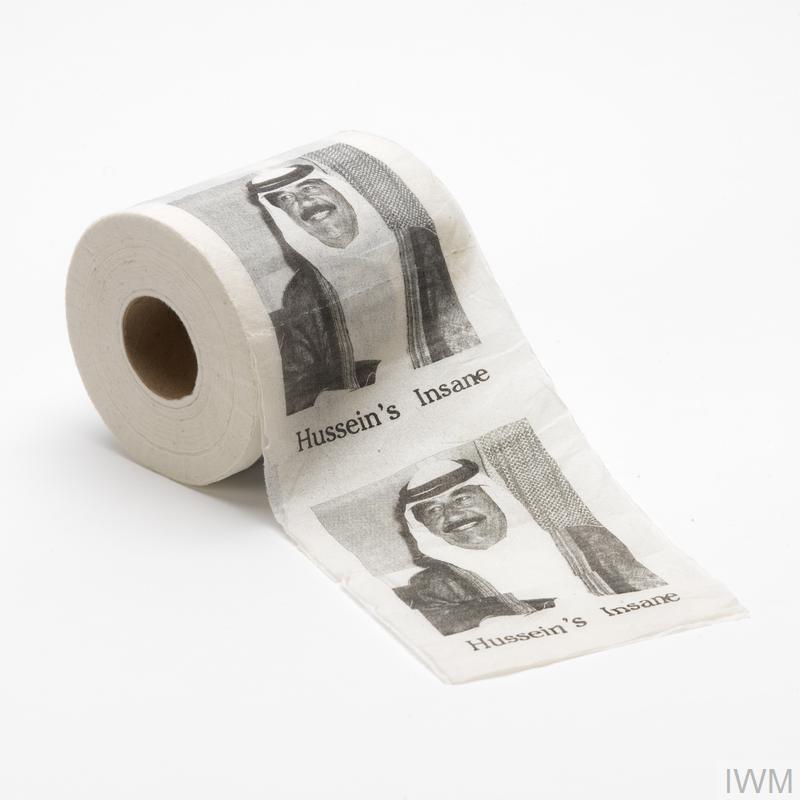Saddam Hussein led Iraq from 1979 to 2003. During his rule he projected an image of himself as Iraq’s most influential leader and a courageous moderniser, but at the same time his repressive regime killed thousands of people.
Saddam was overthrown in April 2003 following the US-led invasion of Iraq, and executed for crimes against humanity in 2006. But over a decade after his death, Saddam’s legacy remains a divisive issue. The instability in Iraq, caused in part by the war, means that some Iraqis long for the security of tyrannical rule, while others cannot forget the extreme brutality he unleashed on the Iraqi people.

Propaganda
Saddam Hussein fostered a personality cult during his rule to inspire devotion from the Iraqi people.
His image was widely circulated and proliferated a range of public spaces.
Britain and the US seized the chance to undermine Saddam’s public support during the Gulf War in 1990, by circulating anti-Saddam propaganda.
On this leaflet, the text reads ‘Wanted The Mother of All Evil’ in English and the Arabic text translates as ‘The cold face of death and war’.
Caricature

Saddam’s image was also widely manipulated in Iraq, he depicted himself in a range of garb from traditional dress to modern business suits to appeal to different aspects of Iraqi society.
Western powers also caricatured his image as a way to mock him.
This British-produced dog toy was manufactured during the Gulf War in 1990, the toy holds a petrol hose to parody Saddam’s control over Iraq’s oil assets.
'MOST WANTED'

The US Invaded Iraq in March 2003 to disarm the country of weapons of mass destruction and end Saddam Hussein's support for terrorism.
The US Department of Defence developed these ‘most wanted’ playing cards to help forces identify members of Saddam’s Regime.
Saddam Hussein, as the most powerful, and most wanted person, appeared on the Ace of Spades, the highest ranking card in the pack.
Removal
Portraits of Saddam Hussein were common sights on the streets of Iraq, displayed everywhere from town squares, to schools, bus stops and cafes.
Following the fall of Saddam, many civilians who feared and detested their former ruler wanted these images removed.
This mural was taken from the entrance of Umm Qsar port in Iraq in March 2003 by the Royal Logistics corps at the request of local people.
Memorabilia

At the same time, souvenirs of Saddam Hussein’s rule also became highly profitable.
April 2003 saw a flood of Saddam related memorabilia appear on online auction sites.
Pieces of broken statues, Iraqi currency depicting his face, and even looted cutlery from his palaces were all purchased for considerable sums on eBay.
Curios from earlier conflicts, like this anti-Saddam toilet paper made during the Gulf War in 1991, also became very popular collectables, despite their less than reverential depiction of the leader!
Destruction
Saddam’s fall was mirrored in the enthusiastic destruction of his image by the Iraqi people. Statues like this bust, were often destroyed and damaged by locals.
The toppling of Saddam’s statue in Firdos Square, Baghdad by civilians and US forces was widely broadcast in the media.
Locals reportedly pelted the image of Saddam with shoes and even urinated on it after its fall.
As sectarian violence erupted and continued in the country, some Iraqi’s reconsidered their actions.
Weightlifter Kadhem Sharif, who was filmed swinging a sledgehammer at the statue in Baghdad in 2003, ultimately came to regret his involvement in its demise.
He confessed in 2016; ‘when I go past that statue I feel pain and shame.’
Legacy

Iraqi artist Jamal Penjweny explores the impact of Saddam Hussein in Iraq through his series of photographs Saddam is Here.
The subjects of his portraits hold an image of Saddam over their faces to obscure both their identities and their feelings about the former dictator. Penjweny says ‘Iraqi society cannot forget him even after his death because some of us still love him and the rest are still afraid of him’
'Saddam is Here' was on display at IWM London as part of Age of Terror: Art since 9/11 until 28th May 2018.




